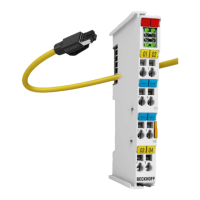Commissioning
EL500x116 Version: 3.6
Multiple transmission mode
The following modes can be used with the SSI protocol:
- Single transmission (already part of EL5002)
- Multiple transmission (new feature, available from FW03 and XML Rev. 0020)
The single transmission is implemented according to the SSI protocol standard. The multiple transmission is
an extension of the single transmission and can be activated by the user for each channel independently.
For the multiple transmission the SSI master sends additional clock pulses / clock bursts (at least additional
one) within the monoflop time. As response the complete data word, that was already transmit after the first
rising clock edge, is expected. The received data values are compared. If there is a difference between the
received data value, an error state indicated by an error bit is set. Therefore the multiple transmission is
ideally suited to check the data integrity.
The multiple transmission can be activated by a CoE object, for each channel independently. The number of
additional send clock bursts can be set by the user.
Index 80n0 SSI settings
Index Name Meaning
80n0:14
[}126]
Number of clock bursts 1: single transmission is active (Default)
2: multiple transmission with 2 clock bursts
3: multiple transmission with 3 clock bursts
The additional clock bursts are send within the monoflop time t
m
, these time is specified:
• Monoflop time of encoder: 15 µs < t
m
< 25 µs
The multiple transmission functionality cannot be guaranteed for monoflop time t
m
< 15 µs.
The number of the additionally send clock bursts is restricted by the baudrate. The higher the baudrate, more
clock bursts can be sent.
While during single transmission received value is directly written to the counter value, for multiple
transmission the first valid value is written to the counter value. This means:
multiple transmission with 2 clock bursts (0x80n0:14):
• Both values are compared. If the values are similar, the first received value is written to the counter
value. If the consecutive received values are different, the transmission failure is indicated by an error
bit in the status byte (SB). The first received value, also if it is not valid, is set as counter value.
multiple transmission with 3 clock bursts (0x80n0:14):
• Three values are compared. At least two out of three values need to be similar. The first valid value is
written to the counter value. If all three received values are different, the transmission failure is
indicated by an error bit in the status byte (SB). The first received value, also if it is not valid, is set as
counter value.
The status byte (SB) is located in the input process image, and is transmitted from the terminal to the
controller.

